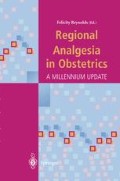Abstract
Only in recent years have there been systematic evaluations of the concentration-response pharmacodynamics for epidural and intrathecal local anaesthetic agents. Whilst these have been determined for inhalation and intravenous anaesthetic agents using the clinical models of minimum alveolar concentration (MAC) and minimum infusion rate (MIR) respectively, the same standards had not been applied to regional analgesic techniques. The majority of research into local anaesthetic dose requirements and the effect on them of other analgesics such as opioids, have generally been in the style of recipe designs with comparisons of fixed combinations of drugs. It is now clear that many of these studies have involved concentrations above the 95th centile for efficacy (EC95), at the top of the concentration-response curve where subtle differences will be missed or apparently similar efficacies misinterpreted. Study designs involving dose-varying regimens such as predetermined multiple dose testing, isobolographic methods and up-down sequential allocation are more informative than fixed recipe designs and allow quantification of effect.
Access this chapter
Tax calculation will be finalised at checkout
Purchases are for personal use only
Preview
Unable to display preview. Download preview PDF.
References
Columb MO, Lyons G. Determination of the minimum local analgesic concentrations of epidural bupivacaine and lidocaine in labor. Anesth Analg 1995; 81: 833–7
Polley LS, Columb MO, Wagner DS, Naughton NN. Dose dependent reduction of the minimum local analgesic concentration (MLAC) of bupivacaine by sufentanil for epidural analgesia in labor. Anesthesiology 1998; 89: 626–32
Bräu ME, Vogel W, Hempelmann G. Fundamental properties of local anesthetics: Half-maximal blocking concentrations for tonic block of Na-and K* channels in peripheral nerve. Anesth Analg 1998; 87: 885–9
Columb MO, Lyons G, Naughton NN, Beckton WW. Determination of the minimum local analgesic concentration of epidural chloroprocaine hydrochloride in labor. International Journal of Obstetric Anesthesia 1997; 6: 39–42
Polley LS, Columb MO, Lyons G, Nair S. Effect of epidural fentanyl on the minimum local analgesic concentration of epidural chloroprocaine in labor. Anesth Analg 1996; 83: 987–90
Christiaens F, Verbough C, Dierick A, Camu F. Effects of diluent volume of a single dose of epidural bupivacaine in parturients during the first stage of labor. Reg Anesth Pain Med 1998; 23: 134–41
Columb MO. Dose, concentration and volume: A triangulated circular argument! International Journal of Obstetric Anesthesia 1998; 7: 64–5
Lyons G, Columb MO, Gorton H. Minimum local analgesic volume for epidural bupivacaine 0.125% w/v in labour. Br J Anaesth 1998; 80: (suppl 1): 149–50
Columb MO, Lyons G, Polley LS, Capogna G, Benhamou D. Minimum Local Analgesic Concentration of Bupivacaine in Labor; a Metanalysis. Proc SOAP 1997; Al25
Capogna G, Celleno D, Lyons G, Columb M, Fusco P. Minimum local analgesic concentration of bupivacaine increases with progression of labour. Br J Anaesth 1998; 80: 11–3
Columb MO, Lyons G, Polley LS, Capogna G, Gorton H. Bupivacaine requirements for labor analgesia. Proc SOAP. Anesthesiology 1999; 90: A74
Lyons G, Columb MO, Hawthorne L, Dresner M. Epidural pain relief in labour; bupivacaine sparing by epidural fentanyl is dose dependent. Br J Anaesth 1997; 78: 493–7
Robinson APC, Lyons GR, Wilson RC, Sabrine A, Columb MO. Levobupivacaine for extradural analgesia in labour; the sparing effect of extradural fentanyl. Br J Anaesth 1999; 82: (Supplement 1) 208
Grass JA, Sakima NT, Schmidt R, Michitsch R, Zuckerman RL, Harris AP. A randomized, double-blind, dose-reponse comparison of epidural fentanyl versus sufentanil analgesia after caesarean section. Anesth Analg 1997; 85: 365–71
Polley LS, Columb MO, Naughton NN, Dorantes DM, Wagner DS, Van de Ven CJM. Effect of intravenous versus epidural fentanyl on the minimum local analgesic concentration (MLAC) of epidural bupivacaine in labor. Proc SOAP. Anesthesiology 1999; 90: A25
D’Angelo R, Gerancher JC, Eisenach JC, Raphael BL. Epidural fentanyl produces analgesia by a spinal mechanism. Anesthesiology 1998; 88: 1519–23
Albright GA. Cardiac arrest following regional anesthesia with etidocaine or bupivacaine. Anesthesiology 1979; 51: 285–91
Knudsen K, Suurküla MB, Blomberg S, Sjövall J, Edvardsson N: Central nervous and cardiovascular effects of i.v. infusions of ropivacaine, bupivacaine and placebo in volunteers. Br J Anaesth 1997; 78: 507–14
Scott DB, Lee A, Fagan D, Bowler GMR, Bloomfield P, Lundh R: Acute toxicity of ropivacaine compared with that of bupivacaine. Anesth Analg 1989; 69: 563–9
Capogna G, Celleno D, Lyons G, Columb M. Determination of the minimum local analgesic concentration (MLAC) of epidural ropivacaine in labour. Br J Anaesth 1999; 82: 371–3
Polley LS. Columb MO, Naughton NN, Wagner DS, Van de Ven CJM. Relative analgesic potencies of ropivacaine and bupivacaine for epidural analgesia in labor: Implications for therapeutic indexes. Anesthesiology 1999; 90: 944–50
McDonald SB, Liu SS, Kopacz DJ, Stephenson CA. Hyperbaric spinal ropivacaine: A comparison to bupivacaine in volunteers. Anesthesiology 1999; 90: 971–7
Santos AC, Arthur GR, Wlody D, de Armas P, Morishima HO, Finster M. Comparative systemic toxicity of ropivacaine and bupivacaine in non-pregnant and pregnant ewes. Anesthesiology 1995; 82: 734–40
Columb MO, Polley LS. Bupivacaine and Ropivacaine: Therapeutic implications. Anesthesiology 1999; 90: A73
D’Angelo R, James RL. Is ropivacaine less potent than bupivacaine? Anesthesiology 1999; 90: 941–943
Lyons G, Columb M, Wilson RC, Johnson RV. Extradural pain relief in labour: Potencies of levobupivacaine and racemic bupivacaine. Br J Anaesth 1998; 81: 899–901
Arkoosh VA, Aluru D, Buxbaum JL, Leighton BL. Intrathecal bupivacaine dose-response in multiparous patients receiving oxytocin. Proc SOAP. Anesthesiology 1999; 90: A66
D’Angelo R, Nelson KE, Meister G, Gaver R, Eisenach JC. Dose response study of spinal fentanyl in early labor. Proc SOAP, Anesthesiology 1998; 89: A17
Columb MO, Polley LS. In reply: Up-down sequential allocation technique to investigate the influence of opioids on the efficacy of epidural local anesthetics in labor pain. Anesthesiology 1999; 90: 1788–9
Editor information
Editors and Affiliations
Rights and permissions
Copyright information
© 2000 Springer-Verlag London
About this chapter
Cite this chapter
Columb, M.O. (2000). Clinical trials: up-down sequential allocation. In: Reynolds, F. (eds) Regional Analgesia in Obstetrics. Springer, London. https://doi.org/10.1007/978-1-4471-0435-3_15
Download citation
DOI: https://doi.org/10.1007/978-1-4471-0435-3_15
Publisher Name: Springer, London
Print ISBN: 978-1-4471-1142-9
Online ISBN: 978-1-4471-0435-3
eBook Packages: Springer Book Archive

